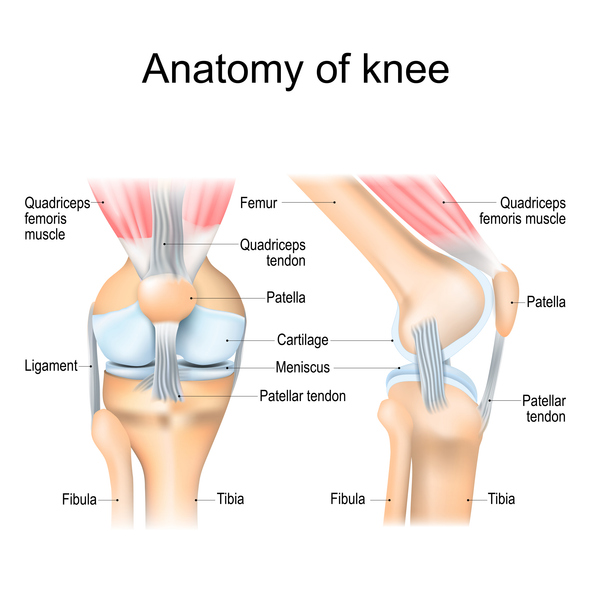The knee is the largest joint in the human body, playing a pivotal role in our mobility, daily activities, and athletic endeavors. These complex structures bear the brunt of our body weight, allowing us to walk, jump, run, and perform a myriad of movements with ease. The surgeons and medical providers at Syracuse Orthopedic Specialists (SOS) are experts in keeping knees healthy and restoring injured knees to functionality.

The knee joint is a biologic marvel, with bones, cartilage, ligaments, and tendons working in harmony. The femur (thigh bone), tibia (shin bone), and patella (kneecap) are the major bones that constitute the knee joint. They are connected by major and minor ligaments, including the ACL and PCL, that provide stability. Tendons connect numerous muscles, including the quadriceps and hamstrings, to the knee bones to allow movement. The knee's smooth movement is further enabled by joint cartilage and meniscus cartilage, as well as synovial fluid, all of which serves to cushion and lubricate the joint. The knee is not just a hinge joint (flexing and extending) but also has rotational and sliding components, making it one of the most complex biomechanical joints in the body.
Todd Battaglia, MD, president of SOS and a lead member of the SOS Sports Medicine team, often sees patients who suffered injuries while playing sports. As baseball season begins, he notes that knee concerns for catchers in baseball (or similar positions in other sports) are significant due to the nature of their roles, which require prolonged periods in a crouched position, rapid movements to block shots or pitches, and frequent physical impacts. These unique demands place a considerable strain on the knee joint, leading to a higher risk of both acute injuries and chronic conditions.
“Sports should be a fun, healthy activity for participants,” comments Dr. Battaglia. “SOS is committed to providing quality orthopedic care for athletes, but we also are dedicated to educating parents and coaches about sports safety and helping prevent injuries so that sports can be an activity enjoyed throughout a lifetime.”
For catchers and goalies, repetitive squatting and sudden movements can lead to overuse injuries such as patellar tendinitis, also known as "jumper's knee," which is an inflammation of the tendon that connects the kneecap to the shinbone. This condition is also commonly seen in jumping athletes, such as basketball and volleyball players, hurdlers, and vaulters. Additionally, the meniscus, a cushion of cartilage between the bones in the knee, can suffer from tears due to the twisting motions often required in these positions. Over time, these athletes may also be at an increased risk for developing osteoarthritis in the knee joints due to the continual wear and tear.

Preventive measures, including proper conditioning, flexibility exercises, and strength training focusing on the muscles around the knees, can mitigate some of these risks. Wearing appropriate protective gear, such as knee pads or braces, can provide support and absorb some of impact. Furthermore, maintaining a healthy weight can reduce stress on the knees.
Treatment for knee injuries should be sought promptly, and recommendations should be followed rigorously to ensure a full recovery. Techniques and strategies to minimize the time spent in potentially harmful positions, without compromising performance, can also be valuable. Ultimately, understanding the risks and implementing a comprehensive approach to prevention and care can help catchers and goalies protect their knees, extending their playing careers and maintaining their quality of life off the field.
Despite the best in technique and equipment, knee injuries are never completely preventable. The sports specialists at SOS are experts in treating these ligament, tendon and cartilage injuries, and returning athletes to their previous level of performance in a safe, effective and speedy manner. According to Dr. Battaglia, “We frequently treat athletes from the highest levels of competition, including Division I college and professional athletes. There are essentially no sports injuries we are unable to manage here in Syracuse with the same techniques and success rates as leading centers in larger cities.”
Even with the best care, some athletes and others do experience more general knee deterioration as they age. Today, people have longer life expectancies and greater activity levels, and joint replacement is being performed in greater numbers on younger patients. This is due both to increased need and to new technological advances that make it more appropriate for younger patients than it has been in the past.
Knee replacement surgery is a procedure undertaken to relieve pain and restore function in severely diseased knee joints. It is a common but major surgery aimed at improving the quality of life for individuals suffering from osteoarthritis, rheumatoid arthritis, or post-traumatic arthritis when other treatments fail to provide relief. “We have some of the nation’s best knee replacement surgeons right here at SOS,” notes Dr. Battaglia. “SOS’s joint replacement team performs more 3,000 joint replacements per year, with significantly higher satisfaction rates and lower complication rates than national averages.”
Maintaining knee health is crucial for overall well-being and mobility. Regular exercise, maintaining a healthy weight, and avoiding undue stress on the knees can prevent many common knee problems. Taking proactive measures to protect our knees ensure their functionality and longevity, enabling us to lead active and healthy lives. There are non-surgical and surgical treatments for knee pain and the SOS Team will help guide you and customize treatment no matter what your knee injury may be.
Looking for places to enjoy Central New York and be active? Here's a list of hikes with waterfalls - Visit Syracuse: Go Chasing Waterfalls

Chittenango Falls - Source: Instagram: juliebrose
